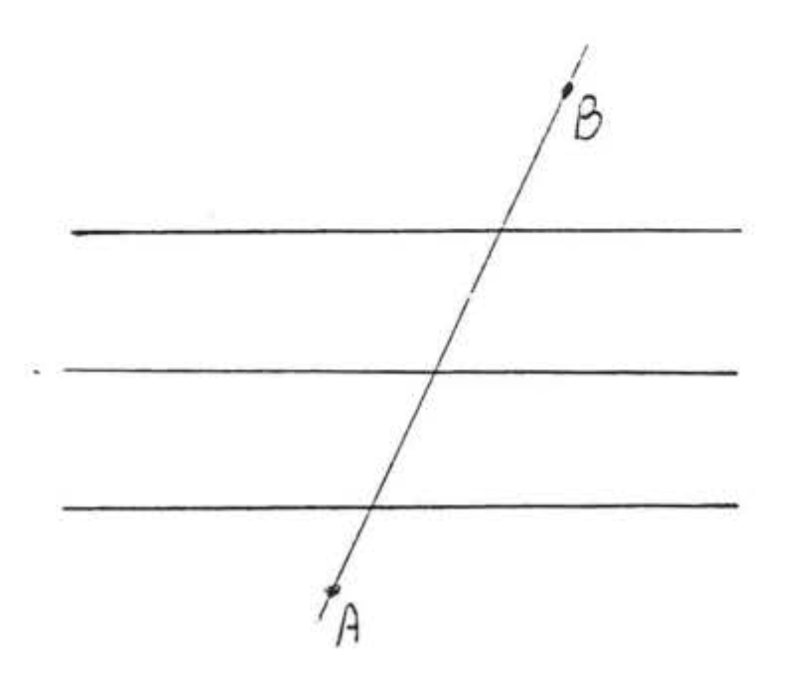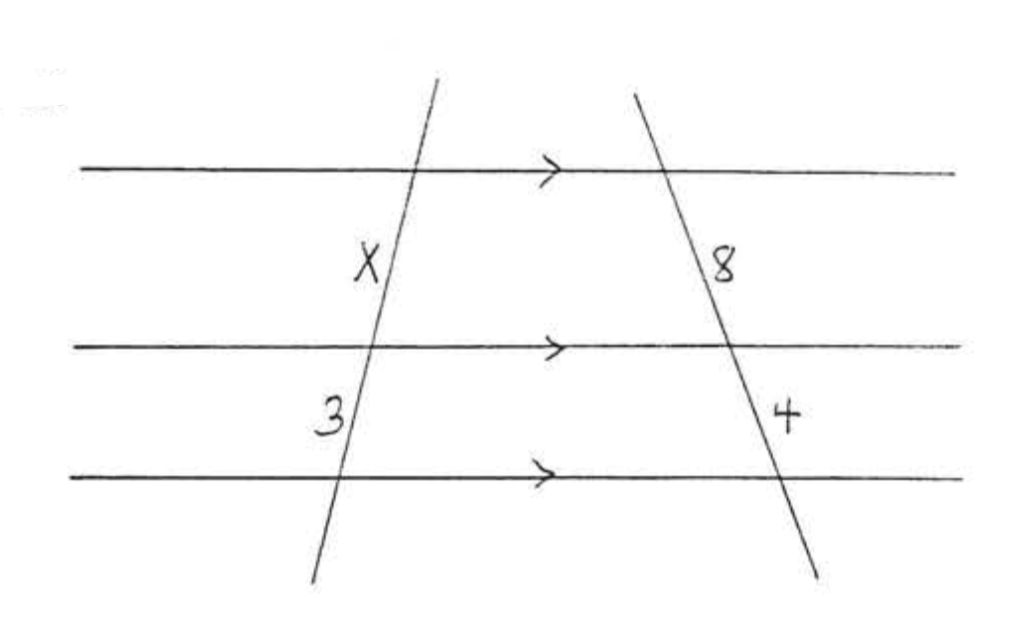4.3: Transversales a Tres Líneas Paralelas
- Page ID
- 114597
\( \newcommand{\vecs}[1]{\overset { \scriptstyle \rightharpoonup} {\mathbf{#1}} } \)
\( \newcommand{\vecd}[1]{\overset{-\!-\!\rightharpoonup}{\vphantom{a}\smash {#1}}} \)
\( \newcommand{\id}{\mathrm{id}}\) \( \newcommand{\Span}{\mathrm{span}}\)
( \newcommand{\kernel}{\mathrm{null}\,}\) \( \newcommand{\range}{\mathrm{range}\,}\)
\( \newcommand{\RealPart}{\mathrm{Re}}\) \( \newcommand{\ImaginaryPart}{\mathrm{Im}}\)
\( \newcommand{\Argument}{\mathrm{Arg}}\) \( \newcommand{\norm}[1]{\| #1 \|}\)
\( \newcommand{\inner}[2]{\langle #1, #2 \rangle}\)
\( \newcommand{\Span}{\mathrm{span}}\)
\( \newcommand{\id}{\mathrm{id}}\)
\( \newcommand{\Span}{\mathrm{span}}\)
\( \newcommand{\kernel}{\mathrm{null}\,}\)
\( \newcommand{\range}{\mathrm{range}\,}\)
\( \newcommand{\RealPart}{\mathrm{Re}}\)
\( \newcommand{\ImaginaryPart}{\mathrm{Im}}\)
\( \newcommand{\Argument}{\mathrm{Arg}}\)
\( \newcommand{\norm}[1]{\| #1 \|}\)
\( \newcommand{\inner}[2]{\langle #1, #2 \rangle}\)
\( \newcommand{\Span}{\mathrm{span}}\) \( \newcommand{\AA}{\unicode[.8,0]{x212B}}\)
\( \newcommand{\vectorA}[1]{\vec{#1}} % arrow\)
\( \newcommand{\vectorAt}[1]{\vec{\text{#1}}} % arrow\)
\( \newcommand{\vectorB}[1]{\overset { \scriptstyle \rightharpoonup} {\mathbf{#1}} } \)
\( \newcommand{\vectorC}[1]{\textbf{#1}} \)
\( \newcommand{\vectorD}[1]{\overrightarrow{#1}} \)
\( \newcommand{\vectorDt}[1]{\overrightarrow{\text{#1}}} \)
\( \newcommand{\vectE}[1]{\overset{-\!-\!\rightharpoonup}{\vphantom{a}\smash{\mathbf {#1}}}} \)
\( \newcommand{\vecs}[1]{\overset { \scriptstyle \rightharpoonup} {\mathbf{#1}} } \)
\( \newcommand{\vecd}[1]{\overset{-\!-\!\rightharpoonup}{\vphantom{a}\smash {#1}}} \)
En el Capítulo 1 definimos una transversal para ser una línea que intersecta otras dos líneas, ahora extenderemos la definición a una línea que intersecta otras tres líneas. En la Figura\(\PageIndex{1}\),\(AB\) es una transversal a tres líneas.

Si las tres líneas son paralelas y tenemos dos de esas transversales podemos exponer el siguiente teorema:
Los segmentos de línea formados por dos transversales que cruzan tres líneas paralelas son proporcionales.
En la Figura\(\PageIndex{2}\),\(\dfrac{a}{b} = \dfrac{c}{d}\).

Encuentra\(x\):

Solución
\[\begin{array} {rcl} {\dfrac{x}{3}} & = & {\dfrac{8}{4}} \\ {4x} & = & {24} \\ {x} & = & {6} \end{array}\]
Comprobar:

Respuesta:\(x = 6\).
Dibujar\(GB\) y\(HC\) paralelo a\(DF\) (Figura\(\PageIndex{3}\)). Los ángulos correspondientes de las líneas paralelas son iguales y así\(\triangle BCH \sim \triangle ABG\). Por lo tanto
\[\dfrac{BC}{AB} = \dfrac{CH}{BG}.\]
Ahora\(CH = FE = c\) y\(BG = ED = d\) porque son los lados opuestos de un paralelogramo. Sustituyendo, obtenemos
\[\dfrac{a}{b} = \dfrac{c}{d}.\]

Encuentra\(x\):

Solución
\(\begin{array} {rcl} {\dfrac{x}{3}} & = & {\dfrac{2x + 2}{4x + 1}} \\ {(x)(4x + 1)} & = & {(3)(2x + 2)} \\ {4x^2 + x} & = & {6x + 6} \\ {4x^2 - 5x - 6} & = & {0} \\ {(x - 2)(4x + 3)} & = & {0} \end{array}\)
\(\begin{array} {rcl} {x - 2} & = & {0} \\ {x} & = & {-2} \end{array}\)o\(\begin{array} {rcl} {4x + 3} & = & {0} \\ {4x} & = & {-3} \\ {x} & = & {-\dfrac{3}{4}} \end{array}\)
Rechazamos\(x = -\dfrac{3}{4}\) porque\(BC = x\) no puede ser negativo.
Comprobar,\(x = 2\):

Respuesta:\(x = 2\).
Problemas
1 - 6. Encuentra\(x\):
1.

2.

3.

4.

5.

6.



